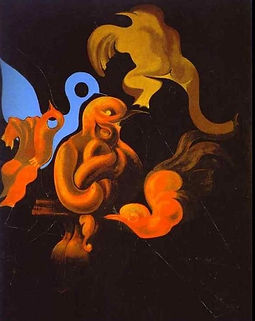Conor O'Donnell
Max Ernst
Foundation Beyeler
June 2013
Basel, Switzerland

Oedipus Rex 1922

Vision Induce by the Nocturnal Aspect of the Porte Saint-Denis 1927

You can arrange art exhibitions historically, sociologically, geographically, by categories of the used materials, by occupations, artistic themes, and aesthetics or in the case of this exhibition chronologically. This is generally the standard format of choice in large scale retrospectives and is effective when dealing with Max Ernst’s work that was heavily influenced by developments in the art world, the political turmoil of the two world wars, innovation in techniques and geographical influences.
If there is a theme in this exhibition it is his constant evolution and influence on the art world. You see his development and use of new techniques such as collage, frottage, grattage, decalcomania and oscillation. What was wonderful about this show where the insightful and detailed description of how he used these techniques and how different effects were created

This gave a real technical education to the viewer along with the mysterious philosophical and psychological concepts of his work. Also as you passed through this vast collection of over 160 paintings, drawings, sculptures and prints different artist names poped into your head that he influenced and was influenced by such as Francis Bacon, Alberto Giacometti, Joan Miró, Giorgio de Chirico, J.G. Ballard, Henri Rousou, and many of the American abstract expressionism artist.
After us Motherhood 1927
A Moment of Calm 1939

The Entire City 1925

The King Playing with the Queen 1944
Interpreting the work of Max Ernst is in my opinion always a personal experience. You can attain a certain amount of background knowledge on what happened to him as a child or what he was interested in or experiencing politically but the final few steps are always left for the viewer to take by themselves. For example you can know that Ernst was preoccupied with the work of Sigmund Freud and the subject of dreams, mythology and the surreal while he was painting Oedipus Rex 1922 but it doesn’t help you explain what the birds and the walnut mean in connection to the mother son reference in the title. You can know he uses frottage as a starting point to find new worlds to explore with his imagination in works such as The Entire City 1935 but that lead is down to you to figure out and interpret.

At the First Clear Word 1923
An example of his improvisation can be seen in the piece Vision Induce by the Nocturnal Aspect of the Porte Saint-Denis 1927. Here Ernst’s uses the technique of grattage an artistic technique that Ernst devised as a semi-automatic process. It involves building up layers of paints and then placing textured materials under the canvas and then pressing and making impressions into the paint. He would then rework this and re-interpret these semi random patterns into new imaginary landscapes based on memory and dreams. You can see more use of this technique in works like A Moment of Calm 1939 and The Entire City 1935/36
I think the struggle within Ernst’s work can be seen being consciously discussed in the piece The King Playing with the Queen 1944. This bronze sculptor shows the king who has taken himself out of the board maybe representing Ernst trying to attain a sense of control in his life through his art. But is he showing us everything or is everything we see in this show just an edited controlled representation of what he wants us to see. The truth lies hidden like the pawn the king holds behind his back. If he is depicting himself as the all-powerful strategist then he is also depicting himself as a cheat and as a dishonest person.
What I will take away from this show is more confidence in the control of information that I release about my work. I am willing to explain my process and the areas I am researching but the final meaning has to be interpreted by the viewer. Those final few steps should always be lonely and an element of mystery lasts longer than a curious fact.